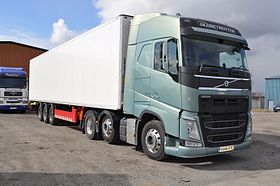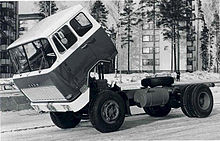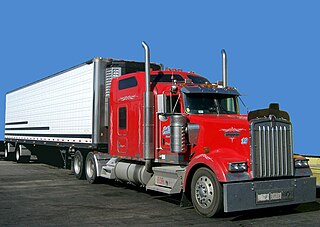 Volvo FH cab-over | |
| Overview | |
|---|---|
| Manufacturer | Various |
| Also called | COE, forward control |
| Production | 1899–present |
| Assembly | Worldwide |
| Body and chassis | |
| Class | Light, medium, and heavy |
| Body style | Cab over engine |
Cab-over, also known as cab over engine (COE), cab forward (U.S.), flat nose (Canada), or forward control (UK), is a body style of truck, bus, or van that has a vertical front, "flat face" or a semi-hood, with the cab of the truck sitting above (or forward of) the front axle. This contrasts with a conventional truck where the engine is mounted in front of the driver.
Contents
This truck configuration is currently common among European and Asian truck manufacturers. European regulations set restrictions for both the total length and the length of the load area, which allow a cab length of 2.35 m (7 ft 8+1⁄2 in) in combination with the maximum load area length. This allows a sleeper cab with a narrow bunk, and would allow a bonneted (hooded) day cab. Nonetheless, no manufacturer in Europe produces such day cabs with bonnets. The last manufacturer of a conventional in Europe, Scania, stopped production in 2005 due to a decline in sales to less than 1000 units worldwide, with European sales declining by 50% and sales in South America by 90%, within one decade. Generally speaking, Asian regulations are even stricter, and the relatively shorter journey distances allow more heavy trucks to forgo sleepers to save even more length.

Cabover trucks are widely used in the United States for refuse collection, terminal tractors, and other vocational applications requiring a tight turning radius or frequent ingress/egress by the driver. Autocar, the oldest surviving motor vehicle manufacturer in America, produces primarily cabover trucks. Although cabover trucks were popular among United States heavy truckers and trucking companies during the 1970s because of strict length laws in many states, when those length laws were repealed, most heavy-truck makers moved to other body styles. One of the reasons is the Federal Bridge Formula, which is unique to the US, and encourages spreading out the load. If axle distances are too tight, the maximum load allowance is reduced. For COEs operated at maximum weight in the US, this required an axle directly behind the front bumper. This cab design caused an awkward climb into the cab for the driver, forcing them to climb up behind the front wheel, then moving to the front and into the cab. European or Chinese or Japanese truckers enter their cab in a straight fashion with handrails left and right.
Cabovers are also very popular in the US's light- and medium-duty truck segment where compact size is required for urban mobility without sacrificing payload; Toyota subsidiary Hino, Isuzu, and Mitsubishi Fuso models are a regular sight for this reason. American company Paccar (which owns the Kenworth and Peterbilt brands) still manufactures traditional cab over engine designs for the Australian and South African markets where length restrictions still make them advantageous.
In Australia, both American (cab over axle) and European/Japanese/Chinese (cab forward of axle) types, as well as the conventional type are common. Cab over engine types dominate urban and light duty use, with conventional trucks predominating in remote and off-road areas. Both types are common for highway use.























